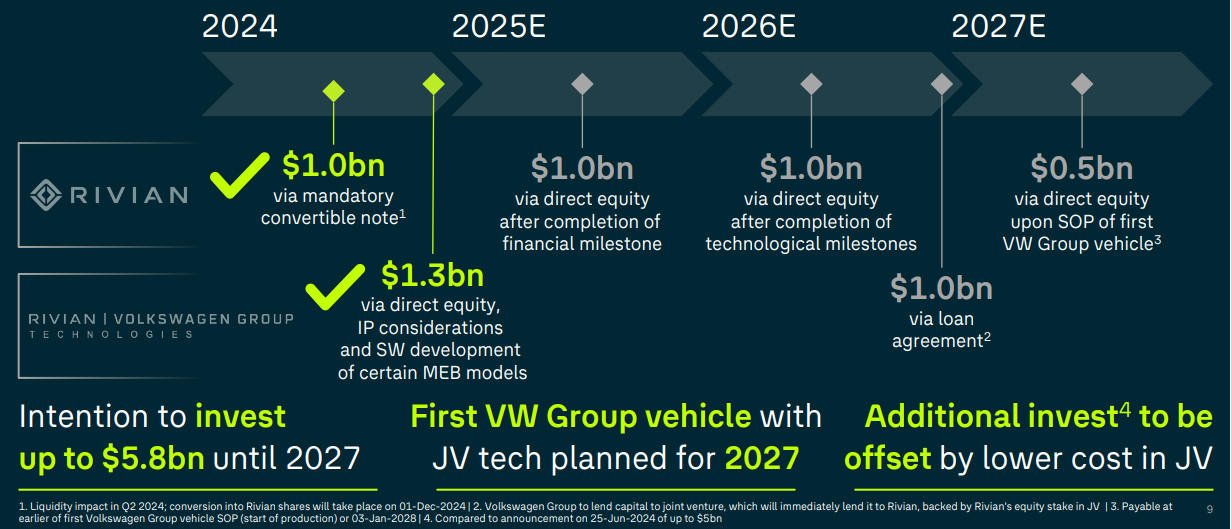While 2025 could shape up into a rather quiet year for Rivian Automotive (RIVN -0.14%), with a lack of major launches or catalysts, the end of 2024 has been anything but muted. Investors have to digest potential tariffs ands the impact of potentially losing the $7,500 federal tax credit for electric vehicles (EVs).
On the positive side, Rivian also was looking at a huge Volkswagen joint venture, valued up to $5.8 billion, as well as a Department of Energy (DOE) conditional commitment for a $6.6 billion loan. Let’s dig a little deeper into the Volkswagen joint venture and the DOE loan to see whether they’re as solid as we think.
Show me the money
When it comes to the Volkswagen deal, the global automaker has already put some of its money where its mouth is, in terms of the joint venture.
Image source: Volkswagen JV presentation.
Let’s take this step by step, with the first being that Volkswagen invested $1 billion into Rivian upon announcing the joint venture in June. The liquidity impact was felt in the second quarter. Volkswagen then injected another $1.3 billion through direct equity. Investors can take that to the bank, but the next step will take some work.
Volkswagen will invest another $1 billion through direct equity after completion of a financial milestone. To meet that milestone, Rivian will have to post two nonconsecutive quarters of $50 million of gross profit, or two consecutive quarters of gross profit. This is unlikely to be completed during the first half of 2025, and it’s not guaranteed to be completed in 2025.
It makes watching the fourth quarter even more important as the company expects to use roughly $275 million in regulatory credits in the fourth quarter, and it could satisfy half of the $50 million gross profit milestone.
The next $1 billion chunk from Volkswagen will come at the completion of a technological milestone. More specifically, Rivian will need to successfully test the joint venture’s technology in winter testing in one or more vehicles.
The next $1 billion comes in the form of an option. Rivian has the option to draw a $1 billion loan in October 2026. The loan will have an interest rate equal to Volkswagen’s cost of debt on a seven-year maturity, plus 25 basis points, which are probably better terms than Rivian could get on its own. The loan wouldn’t require principal repayments until 2029.
The last $0.5 billion will be through direct equity upon the start of production of the first Volkswagen vehicle using the technology, or Jan. 3, 2028, whichever comes first. Volkswagen will also fund 75% of the shared platform costs within the joint venture through 2028, with Rivian covering the remaining 25%. Then in 2029, VW will fund an incremental $100 million per year of the joint venture’s shared costs, reducing Rivian’s obligation further.
Nothing is guaranteed, but on paper this is a fantastic deal for Rivian, and the biggest hurdle for investors to watch will be satisfying the financial milestone for gross profit.
Enter the DoE
Rivian also notched another victory, when it received a conditional commitment from the DOE’s Advanced Technology Vehicle Manufacturing loan program for a loan of up to $6.6 billion.

Image source: Department of Energy.
Receiving the commitment means Rivian is currently working on Step Five, when it needs to provide financing documents and other conditions to close the deal. Then, and only then, can funds be distributed.
This is where we enter some uncertainty, as President-Elect Donald Trump and his transition team have made it clear their intentions to roll back support for the EV industry, including the $7,500 federal tax credit for EVs. If Rivian can complete Step Five before the transition team could potentially revoke or complicate the loan distribution, that would be another win.
The important part of the loan itself is that the DOE’s Loan Programs Office can provide the debt at U.S. Treasury rates, and these low-cost loans would be a huge relief to a young startup company. That’s especially true when you consider that Rivian had previously downsized and delayed its Georgia factory, and this loan would specifically support the construction of that factory.
In other words, this DOE loan would provide significant funding for production of the company’s midsize platform that will produce the R2, R3, and R3X. It’s also a vote of confidence, because a requirement in the approval process is a reasonable prospect of repayment.
What it all means
Make no mistake. These were two huge victories, but it’s also important to realize that hurdles and challenges remain, and that nothing is ever guaranteed. Rivian seems well-positioned to maximize its Volkswagen deal even if it takes longer than investors would like. It has up to five years to complete the financial milestone. And if it can close the DoE loan sooner, rather than later, Rivian would be setting itself up nicely for its push to 2026 when it launches the R2, and potentially the R3 and R3X.
Rivian remains a highly speculative stock and should remain a small position in your portfolio, but these were indeed two big victories, even after sorting all the details. That’s great news for investors.

